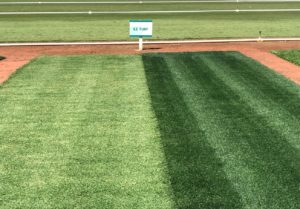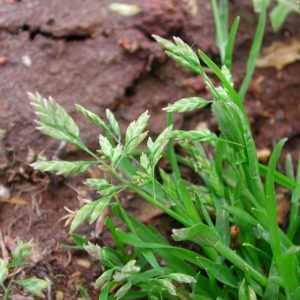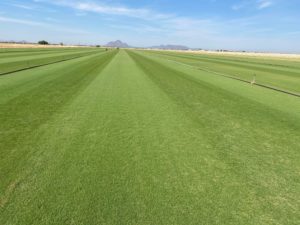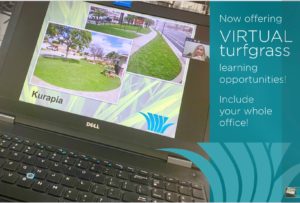Mar
When Should I Start to Spring Transition My Lawn to Bermudagrass?
I’d like to go over some common questions I have received through the blog in the last few weeks and see if it can help others with some of the same concerns. I always encourage everyone to send over your lawn questions and I will get back to you as soon as I can.
When should I start to transition my lawn back to bermudagrass?
I always recommend starting the process slowly in March and ramping up in April so your lawn has transitioned by May. I know that was a mouth full, but the truth is it’s not a short process unless you chemically transition your lawn. In March its ideal to start to gradually lower your mowing height and remove some of the turf canopy. This is not a scalp, this is lowering the height so the bermudagrass can breathe and get some sunlight. By mid-March you should be mowing two times per week and starting to see some thinning in the ryegrass. By thinning I mean bermudagrass leaves are starting to show between the ryegrass blades. Currently there is no need to fertilize the ryegrass, its time to back off on nutrition until bermudagrass season. In early April you can lightly verticut or even lightly power rake the lawn to remove some of the ryegrass giving way to bermudagrass. The more sunlight you can get in the grass, the faster you will transition. If the ryegrass remains extremely thick and lush you can expect it to provide excessive spring shade slowing down the bermudagrass. When soil temperatures reach 64 degrees (around April 15th) go ahead and apply ammonium sulfate 21-0-0 at 5 pounds per 1000 SF to jump start your bermudagrass. Continue mowing two times per week and gradually lowering your heights until you see the bermudagrass take over.
Spring Transition, keep lowering the height…..
Can I still put down pre-emergent for broadleaves?
Most of the grassy weeds and broadleaves are now germinating so putting down the preemergent will not yield the results you’re looking for. At this juncture its best to spot spray weeds depending on the type. Make sure the product is labeled for the weed you’re trying to control and can safely be used on bermudagrass. Grassy weeds use different chemicals than broadleaves and not all chemicals are safe and effective so check with specialty stores for better products.
What can I do to repair the urine damage from my dogs? Read the rest of this entry »
Comments Off on When Should I Start to Spring Transition My Lawn to Bermudagrass?Nov
You’ve Overseeded Your Warm Season Lawn. Now What?
By now, most of you who are going to overseed your California or Arizona sod have either begun the process or have had your seed down for a few weeks. Today, I want to discuss what to do now that you have the ryegrass growing and cooler temperatures are on the horizon.
Getting your ryegrass up and growing is obviously the first step to a successful winter lawn, but what about maintenance? How can you make sure your ryegrass is strong going into the winter and you will have a full stand of ryegrass once the temperatures begin to drop into the 40’s at night? There are several key items associated with a strong winter lawn but early preparation should be high on your list.
I know you put down a starter fertilizer with your seed but let’s remember that fertilizer will move freely in a saturated soil. The new plant took up most of the nutrients from the starter fertilizer application but the residual affect is limited because you’ve been keeping the seed wet for the past few weeks. So what exactly does this mean? Basically, what I’m trying to say is that once you’ve had your ryegrass lawn in for 2-3 weeks I would advise getting a second fertilizer application on the grass.
Comments Off on You’ve Overseeded Your Warm Season Lawn. Now What?Sep
Questions About Fall Overseeding? Check Out This Video Guide From Mr. Wise Grass!
Yes. It is about that time! If you have warm season grass, you are most likely considering overseeding your lawn. Check out this educational video including Q & A from Jay Danek–Mr. Wise Grass himself. After this video you will know exactly what you need to have the best winter lawn in the neighborhood!
Comments Off on Questions About Fall Overseeding? Check Out This Video Guide From Mr. Wise Grass!Aug
KURAPIA GROUNDCOVER SOD BACK IN STOCK!
Great news! We now have our Kurapia drought tolerant groundcover sod back in stock in California and Arizona!
What they’re saying about Kurapia…….
- “After extensive research and investigation, Kurapia was chosen for the following reasons: aesthetics, growth habit, drought tolerance, erosion control, weed suppression, disease resistance, maintenance aspects, and foremost and most importantly–water conservation–with the reduction of water usage. Kurapia met all of these expectations and more. I believe Kurapia will revolutionize the landscape industry
Mark Runk
G&R Engineering
El Cajon, CA
Comments Off on KURAPIA GROUNDCOVER SOD BACK IN STOCK!
Feb
Annual Weed Control and Your Lawn
With the recent rise in temperatures and a little moisture you have likely seen some weeds pop up even if you had put down a pre-emergent in the fall. We have hit the end of the window where the fall application will control the weeds. It is now time to control the weeds that have snuck through your barrier and to put down a control for the summer annuals.
Let us start with controlling the weeds that have made their way through your turf. There are a couple different types of weeds to treat. Before we can give you chemicals to spray its important to recognize the type of grass you’re treating. I will put the recommendations down for a dormant turf lawn and one that has been overseeded with perennial ryegrass for the winter. If you did not overseed in the fall you will follow the dormant turf guidelines. My recommendations will be for bermudagrass so if you have paspalum or St. Augustine make sure you read the herbicide label prior to applying and follow the correct rate. These are usually different than bermudagrass.
Dormant Turf
If you let your Arizona and California lawn go dormant for the winter, it is starting to see a little life now with the warmer temperatures. You will not see any growth until the soil temperature reached 64 degrees which is usually in April, but your lawn will green up in color in March.
First step will be to clean up your lawn by mowing any debris and dead material off the top. This is not scalping the lawn, just get a good clean up. Next step will be to treat any broadleaves or grassy weeds that may have popped through your turf. For broadleaves you can apply 2,4-D and grassy weeds such as poa annua or volunteer ryegrass can typically be hand pulled, dabbed (not sprayed, think bingo dabber) with tiny amount of roundup or a product such as Revolver or Kerb. Because of its very shallow root system you should not have to use any products to kill it. It pulls out of the ground very easily and is usually caused by low areas and too much water.
Poa annua
Comments Off on Annual Weed Control and Your LawnFeb
Pre-Emergent Weed Control/Watering/Fertilizer
We are spending lots of time outside, and I know you all want to have your California and Arizona lawn looking its best! I’d like to talk about a few weeds that may be starting to appear in your lawn that are perennial problems. Let’s discuss getting down a pre-emergent herbicide on your lawn before all the spring and summer annuals start to show their faces. Weather obviously plays a key role in everything we do concerning turfgrass so it is important to get the timing right.
This has been a mild winter with little rain causing the ground temperature to stay slightly warmer than normal so we will have some early season weed issues. If you are in a cooler part of town and are still getting hit with the occasional frosts I would hold off until the first part of March. These cool areas can get the pre-emergent down as late as the middle of March, while areas such as Phoenix and Palm Desert should be putting one down between now and the end of the month.
Since most homeowners have an overseeded lawn for the winter I want to make it clear that there are two options on a herbicide bag. One is overseeded rates and the other is non-overseeded rates. If you would like to keep your ryegrass make sure that you follow the overseeded rate or it could take a turn for the worse rather quickly. Read the rest of this entry »
Comments Off on Pre-Emergent Weed Control/Watering/FertilizerOct
Frequently Asked Questions About Overseeding Your Warm Season Lawn
Now that we’re into October it’s time to get the overseeding of your warm season grass process started. I wanted to pass along some of the most frequently asked questions during this time of the year.
When is the best time to start overseeding?
Ideally overseeding should be done when nighttime temperatures are consistently in the 60’s. Usually this will be in October. There will be some higher and lower than normal temperatures, but anytime during October is good.
How low do I need to scalp the grass prior to seeding?
Height of cut isn’t as important as opening the turf canopy. The shorter you mow the grass, the tighter the turf canopy will be which will result in the need to verticut more aggressively. I recommend not going lower than ½”. There is no need to take the lawn to the dirt or you will cause long term problems to the grass plant.
Aug
Late Summer Sod Tips for California and Arizona Lawns
Summer Sod Tips for California and Arizona Lawns
Summer is wrapping up, the kids are heading back to school, and I’m sure you’re ready to come out of hibernation. While the summer heat is far from over in Arizona and California, it’s going to become tolerable outside. With the slightly cooler mornings it’s time to get back outside and get your lawn ready for fall. Most people start thinking about overseeding their California and Arizona sod in September, but ideally you wouldn’t start the process until October when nighttime temperatures get into the 60’s. Between now and then there are some important steps you need to do to get your lawn ready and to save some headaches down the road.
Between May and September you’ll probably notice your lawn has grown at twice the rate it does during the winter months. Warm season grasses love the warm, wet weather. Most people thought the hot weather would keep the grass from growing well, but remember warm season grasses optimal growing temperatures are between 90-105 degrees. During this season any of your weaker areas should have filled in with the warm season grasses runners. These spots can be slow to fill in during the dry, hot days but as soon as the humidity kicks in the grass really takes off. If you still have large open spots I would suggest picking up a few rolls of sod and patching them prior to overseed. You don’t want to seed directly into the soil.
During the summer months you’re getting lots of new growth on the grass plant and you need to help it thrive. The best way to do this is to thin out the top growth by using a verticut or power rake. Most people only use one during the overseed season but it’s a vital part of promoting new growth during the summer months. When you get too much top growth the grass will get clumpy and keep your new plants from growing. A verticut or power rake will open the turf canopy and thin out the grass plant. Doing so will promote new plant growth. This will also allow you to mow your lawn shorter without scalping. Set the power rake or verticut about halfway down and run over the entire lawn. You can easily mow or rake up the material. Keep in mind that by thinning it now you will save yourself hours of labor during overseed. If you wait until overseed to thin your lawn you may need to repeat this process several times.
For the next month you don’t want to promote top growth unless you don’t plan on overseeding this fall. The more material you have, the more material you will need to remove during overseed. I like to stick to slow release nitrogen products or products that will promote root growth during late summer. There are lots blends that will work but phosphorus and potassium will help your roots at this time of the year.
It’s still too hot to really cut back your water but during the wet periods you can let the lawn stress before you turn the irrigation system back on. Let the lawn go until you see some bluish grey spots appearing in the lawn. These areas aren’t dying but they are stressed. When you see these spots you know it’s time to water again. You can start to back your water down in mid-September when the nights cool off a little more.
If you’ve had persistent weed issues during the winter months you can apply Prodiamine. One product that a lot of people use is Barricade. This must be used 7 weeks prior to overseed. Keep in mind you must wait 7 weeks after you spray this product before you overseed. For the first two weeks of overseed you will need to keep the seed a little more wet than usual so the roots of the new plant can break through the Barricade layer. If you sprayed this week it would have you overseeding in the middle of October which is perfect. The best overseeding period is typically from October 7th-October 31st. Any time you seed during this time frame you will have very little competition from the underlying warm season grass. If you go earlier be prepared for the warm season grass to come back and be actively growing while you’re watering the ryegrass seed.
One way to keep the warm season grass in check is through applications of plant growth regulators such as Trinexapacethyl. One such product that many use is Primo. This can be applied 5-7 days prior to overseeding at .5 oz/1000 SF and right after the first mowing at .35 oz/1000 SF. If you seed during the normal window in October you can skip this step unless you have a very lush, over fertilized lawn going into fall. This is not an endorsement of these products but a generic list of products you can try.
The final thing you can do is mow a little lower for the next few weeks and reduce the turf density. Right before overseed I will tell you to let the grass grow up about 30-40% prior to scalping but you have over a month until you need to worry about it.
Remember when you start to see seed in the stores you want to find a perennial ryegrass that is weed free, and has a high germination rate. Many of the products you will see will be cheap in cost and won’t provide you with a dark green lawn during overseed. I will put out overseed instructions in September as we get closer to the season.
If you have any questions, please hit the “Ask Jay” button at the top right of this page.
Till next time,
Jay
Comments Off on Late Summer Sod Tips for California and Arizona Lawns
Aug
Attention Landscape Architects! We Are Now Offering ZOOM Educational Opportunities!
These are trying times, but that doesn’t mean we have to stop learning. West Coast Turf is now offering virtual Zoom educational opportunities for landscape architects!
Include your whole office! Find out about the newest varieties including the exciting Kurapia sod natural turfgrass alternative ground cover. It’s drought tolerant, unique, versatile, and beautiful. There are some great new native grasses that look spectacular. We also can update you on our old standbys such as West Coaster Fescue, Santa Ana, Bandera Bermuda, and Tifgreen that are tried and true.
Call or e-mail us today to schedule your presentation–760/340-7301 or danielle@westcoastturf.com. The presentation takes about an hour, and we are able to answer any questions you might have on natural turfgrass varieties or Kurapia sod ground cover for your next project.
We miss you and are excited to “see” you again virtually! Contact us today!
Comments Off on Attention Landscape Architects! We Are Now Offering ZOOM Educational Opportunities!










